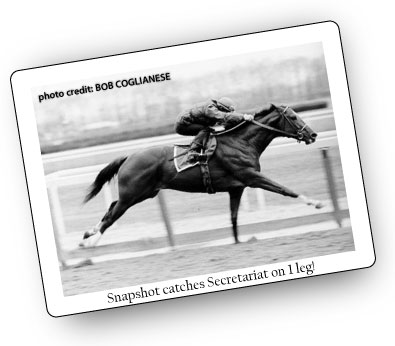ARCHIVE EQUINE NEWS STORIES
| Current news is available at TheHorsePortal.ca, Equine Guelph's online learning platform for practical, quick learning. Given the vast amount of information on horse health and welfare, Equine Guelph has archived its past news articles from 2002-2020. They are listed below, along with a search function available to find specific healthcare topics. | |
Is Your Horse Lame?December 2011

by Henrietta Coole
This snapshot catches Secretariat on 1 leg! In this split second, 2-1/2 times his weight or around 3,000 lbs is exerted on his left front foot. Given that there is no muscle below the knee – only tendon, ligament and bone – it’s not surprising horses are susceptible to injury and lameness.
Equine caregivers know all too well, identifying and treating lameness in horses can be a frustrating and expensive process.
Equine Guelph’s new Lameness Lab online tool, sponsored by Pfizer Equine Division, will help you learn about lameness through interactive activities.
“We think that a visual approach to lameness will greatly help horse caregivers better understand the basics of lameness and how to recognize the signs or symptoms in their horse,” says Dr. Cathy Rae, equine Technical Services veterinarian for Pfizer Animal Health. “This understanding should help them detect lameness earlier as well as guide them in knowing when to call their veterinarian.”
The Lameness Lab will allow horse owners to discover the causes and factors contributing to increased risk. You will learn about the body tissues involved and how to tell if your horse is lame. Plus, see videos of lame horses; test your knowledge and find out how a veterinarian detects lameness.
This online tool features video commentary by Dr. Nicola Cribb, assistant professor and equine surgeon at the University of Guelph, and Dr. Ken Armstrong, equine veterinarian and partner of Halton Equine Veterinary Services.
“I am pleased to help out with the ‘working with the vet’ section of the online tool,” says Armstrong. “In the videos, I explain to horse owners a typical process that vets go through from lameness assessment to diagnosis. Because it’s a team effort between the vet and the owner, it’s important for owners to understand what the vet is doing and why.”
To check out this tool, click on Lameness Lab.